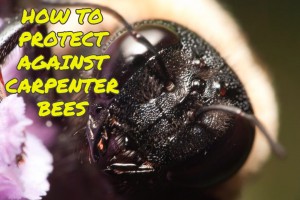 Some of the local east Tennessee news is a buzz (pun intended) with spring emergence of carpenter bees. Springtime, and early summer, is their typical time to show up and start boring their holes into soft wood to create nest spots for laying eggs.
Some of the local east Tennessee news is a buzz (pun intended) with spring emergence of carpenter bees. Springtime, and early summer, is their typical time to show up and start boring their holes into soft wood to create nest spots for laying eggs.
Females will tunnel into softwoods; pine, cedar, or wood structures with outdoor wear. The bees will bore a 1/2inch circle into the wood then turn a tunnel with the grain of the wood. Each ‘cell’ will house one bee egg. Six to Eight cells could be in a single tunnel. Carpenter bee flight is very erratic, which makes them really freaky to be around. Males will often hover around your head if they are disturbed. Only the female bee can sting. The carpenter bee males usually hover around waiting on the female to emerge from a nest in order to mate. After mating the bees will hang out around the nest or smell the flowers. Eggs to adults bees will take about three months to develop. Tunnels or bees not treated early can re-use prior tunnels making the tunnel longer and deeper into wood structures. This can cause actual structure damage and be very difficult to treat.
How to Protect Against Carpenter Bees
- Rarely do the bees attack painted wood. However, it is known to happen on occasion. Good practice is to paint exposed wood. Stained wood is not as effective as painted wood.
- Treat affected areas early to avoid significant damage and make treatment most effective. Similar to termites, carpenter bees do not do quick damage to your home. If ignored, carpenter bees will have significant time to do damage to homes and other wood structures.
- If the female is currently digging a regular wasp spray can kill her and then plug the hole. If you only have time for a temporary fix, use steel wool to plug the hole, then go back and fill in the hole and paint over.
- Treat the chambers and tunnels with insecticidal dusts, wettable powders or residual aerosol formulations. Just caulking over a hole will not suffice, carpenter bees will come back and bore through the caulk. An insecticide is needed to prevent the bees from continually coming back to your home.
- When applying insecticide, put entrance of tunnels in the evening when the bees are less active. Do not cover holes, the bee needs to move from cell to cell carrying the insecticide. The adult bee will die after a day or two.
- Seal the holes with wood pieces, wood putty/carpenters glue, or other sealant to prevent the bees from using the holes again. Not to mention, doing this will prevent the wood from deteriorating as it is compromised by the bees.
- Bit of a home remedy using WD-40 with its spray tube can be used to spray into the bee tubes and break apart the larvae & cells. This might not prevent your current crop of carpenter bees from bugging you, but it will help prevent future carpenter bees from emerging. Plug the created bee holes when you are satisfied with their removal.
If you are unsure about how to treat carpenter bees yourself give us a call (866-448-2847), or email, to schedule a free inspection appointment and we can help you solve your carpenter bee problem.